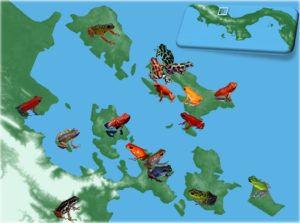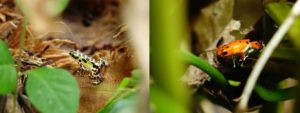
WARNING: Do not ingest, toxic!
Poison frogs (family Dendrobatidae) are some of the most spectacularly colored members of the animal kingdom and like many other dangerous or toxic animals, including venomous coral snakes and stinging bees, their bright colors act as a signal that warns potential predators to stay away. This combination of “danger” plus bright coloration is called aposematism.
Poison frogs are some of the most spectacularly colored members of the animal kingdom.
Poison frogs get their name from their ability to accumulate toxins in their skin, which they acquire through their diet. Some species’ toxins are so potent that indigenous groups in Central and South America used the skin secretions from these tiny frogs to coat the tips of the darts they used for hunting (hence the other common name for this group, the poison dart frogs). In fact, poison frog toxins continue to be of use to humans today for understanding physiological processes like heart function and pain sensation. For the frogs, however, their toxicity needs only to teach its natural enemies not to bother attacking again, which is where the bright, warning coloration comes in handy.
Because the effectiveness of animal warning signals depends on a the ability of a predator who has had a bad experience with one individual to recognize and that signal when they see it again, theory suggests that all individuals of the aposematic species should look alike – the more consistent the warning signal, the easier it is for the predator to learn to avoid it. However, in poison frogs and some other taxa where aposematism is common striking examples of warning color diversity can be found.
The strawberry poison frog example

The strawberry poison frog (Oophaga pumilio) provides a great example of this. These thumbnail sized frogs come in almost every color of the rainbow and are especially variable in color in the Bocas del Toro Archipelago off the coast of Panama. Research in our group has focused on uncovering how selection, both natural and sexual, might have contributed to the evolution of this amazing color diversity.

In this study, we took advantage of an area where two distinct color morphs of O. pumilio occur in the same population (one red and one yellow, but both with large black spots) to test for differences in survival and predator attack rates between color morphs and learn about the potential role of natural selection in shaping color diversity. Because in most of the adjacent populations frogs of this species are red, we predicted that more predators would have learned to avoid attacking red frogs than yellow ones, leaving the much less common yellow morph more vulnerable to attack.
To test our predictions, we used a combination of approaches including the use of red and yellow soft clay model frogs, which preserve evidence of predator attacks, a mark-recapture study, which permits comparison of survival rates for red versus yellow frogs, and visual modeling, which allows us to ask whether the frogs’ colors, that appear very distinct to the human eye, are distinguishable by a suite of potential predators with different visual sensitivities.
Contrary to our expectations…
Our results surprised us! Both approaches we used suggested that red and yellow frogs do equally well, despite the fact that these colors are predicted to be both distinguishable and conspicuous to a variety of potential predators. These findings suggest that counter to what we would expect based on aposematism theory, predation is not constraining the coloration that these frogs can exhibit. Instead, it appears that predators avoid both colors efficiently, even though yellow is rare. Perhaps attacks on these island frogs are so few and far between that natural selection is not constraining the evolution of coloration? If so, perhaps the answer to why these frogs are so incredibly color diverse is tied to sexual selection, given that the mate preferences of this species are also influenced by color!
Read full article: No evidence for differential survival or predation between sympatric color morphs of an aposematic poison frog
Cori Richards-Zawacki
Latest posts by Cori Richards-Zawacki (see all)
- A frog of a different color - 22nd November 2016